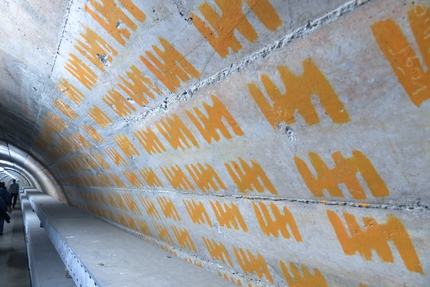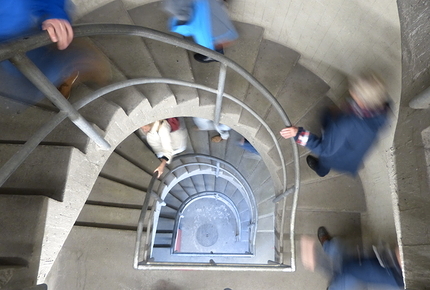Going Underground
Built in 1976, the Sonnenberg bunker in Lucerne, Switzerland, is one of the world’s largest civilian nuclear shelters, once intended to protect 20,000 people against nuclear threat at the height of the Cold War. Forty years on, Caroline Bishop imagines what it might have been like to be holed up there for two weeks with 19,999 others.
July 25th
I’m four days in, sitting in the artificial semi-light that comes with living underground. Though the orange square on the wall clock tells me it’s midday and not midnight, it could just as easily be. I’m tired, as always. Daniel is snoring and Bea’s five-year-old is blubbering – as always.
It feels so much longer than four days ago that we queued for hours at the tunnel’s blast doors, lugging backpacks weighed down with the required two weeks’ worth of ready-to-eat food – tinned spaghetti, jam, crackers, dried fruit – until they finally let us in to this ‘refuge’. Such relief, after waiting for the siren while we simmered under the threat of nuclear attack. But after four days of living like this, it doesn’t feel such a relief any more.
I’m writing this from my cramped bunk. Right next to me lies Ruedi, my 61-year-old neighbour from my apartment block on Bergstrasse, a short walk from here and the reason I’m allocated a space in this bunker. Before this our relationship consisted of a friendly Grüezi when we crossed paths in the foyer of our building. Now we lie so close I can smell his ripe breath. Still, it’s good to have familiar people around me, just a few among thousands of strangers. Small comfort.
I queued an hour for the toilet earlier in a block of around 20 loos – or buckets, really – shared by more than 700 of us. There are no showers so we stink. I haven’t slept properly since I got here, as the dorm hums all day and night with people turning in their creaky bunks, coughing, snoring, eating, farting. There’s nowhere to walk to, apart from up and down the tunnel. No way to see daylight. I feel like a rat in a sewer.
I’m actually in a motorway tunnel under the Sonnenberg mountain. I’ve driven through it many times. Never did I think I’d end up living here. But I knew the city planned a second use for it, should the day ever come. And now it has. No traffic; instead there are 20,000 wonky bunk beds lined up in dorms along this 1.5km twin tube tunnel, while within the mountain above us the seven-storey operation centre they spent six years and 40 million francs building is keeping us in check.
There’s already one person in the prison cells and several in the hospital. An appendix out. Two births. One heart attack. The regular radio broadcasts tell us we’re in safe hands. They’ve thought of everything. I’m not so sure. I’m beginning to wish I’d taken my chances outside instead.
 20,000 marks for every tunnel occupent
20,000 marks for every tunnel occupentCaroline Bishop
July 28th
I’m bored beyond comprehension. I could only fit two books in my backpack, what with all the food, and I’ve read them both twice. My neighbours and I are all out of conversation. There’s nothing more to say – apart from sniping at each other’s irritating habits that we’ve come to know so well. Sarah came back from the hospital just now. Stomach bug. There’s something going round. The toilet queues are even longer. She said the hospital’s walls are painted yellow and green to represent the sun and nature. Who are they kidding? Even in my increasingly unhinged state I’m not going to hallucinate beautiful Rigi mountain and Lake Lucerne. I wish I could.
July 31th
With nothing to do I’m thinking too much. And with thinking comes imagination – of what’s happening above us, what Lucerne will look like when we emerge, and what could happen to me in here before we do. I can see the rising panic in other people’s eyes and I can feel it bubbling up in myself too.
This morning an old man was beaten up and his food stolen. The guy who did it is in the cells upstairs, but it’s made us all distrustful. I’m so sick of eating cold beans from the tin (no cooking facilities here), but I’m also scared of running out of food or having it stolen. I guard it in my bunk like a Rottweiler while ogling other people’s. I sleep clutching crackers.
August 2nd
A lull has fallen over the bunker today. I feel permanently drowsy, limbs like lead. Perhaps it’s because I haven’t slept properly since I got here. Or perhaps, as Bea believes, they’ve reduced the oxygen supply to calm us down, to ease the hysteria I hear in children’s cries and their parents’ sharp tongues. Hysteria fuelled by another rumour – that the 350-ton blast doors at each end of these tunnels, making us prisoners here for our own safety, don’t even shut properly.
August 4th
I’m out. My legs are weak from lack of use. I’ve lost five kilos. Daylight hurts my eyes. Physical reminders of what now feels like a surreal dream.
 Staircase in the seven-storey operation centre
Staircase in the seven-storey operation centreSonnenberg tunnel
I’m relieved to be out of what I came to view as a hellhole, not a refuge. And I’m relieved that Lucerne hasn’t, as we feared, been bombed to oblivion while we were underground. But I’m also left in disbelief. How did the city authorities ever think sheltering a third of Lucerne’s population in one place could work? The logistics couldn’t meet the scale of their ambition. Not only did the bunker take two weeks to set up after closing the tunnels to traffic (what if the city had been bombed while we were waiting?) but then it could only ever keep us safe for a fortnight. So yesterday, when we finally ran out of food and water, we were booted out, jostling our way into the open air before hysteria could consume us entirely. Lucerne may still be here, but so is the nuclear threat. So what now?
-------
Geographically at the heart of Europe, Switzerland was twitchy about the nuclear threat during the Cold War, even if it was a neutral country. In 1963 it passed a law to guarantee enough shelter space for every citizen, a law that is still in force today despite attempts to repeal it. The Sonnenberg is still maintained as a shelter, though its capacity was downsized to 2,000 beds in 2006. You can get your own impression of life underground by joining a public tour, in English, held on the last Sunday of every month. unterirdisch-ueberleben.ch
Do you have any Feedback about this page?
© 2025 Columbus Travel Media Ltd. All rights reserved. No part of this site may be reproduced without our written permission, click here for information on Columbus Content Solutions.









 You know where
You know where